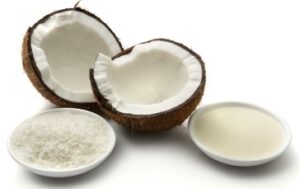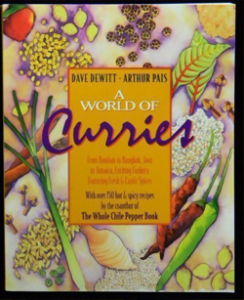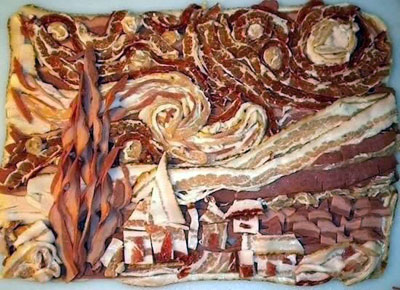In addition to the numerous spices found in the curries of southern India, there is one other enormously important ingredient: the coconut. It is difficult to imagine a social function in many southern Indian states where the auspicious coconut is not present. At wedding ceremonies and the breaking of ground a construction sites, a coconut is broken. According to tradition, the act is a powerful but bloodless sacrifice to invoke the blessings of the gods. In thousands of temples across southern India, priests break a coconut before representations of the gods and distribute its kernel (the meat) to devotees as a sort of communion.

The Hindu scriptures refer to the coconut as the sriphala —the holy or sacred fruit. In fact, many Hindus call it the kamadhenu, the source of life. The three “eyes” on the coconut, some Hindus believe, represent the Hindu trinity of Brahma, Vishnu, and Shiva. However, revered the coconut is in Hindu society, it is also an integral part of Muslim, Christian, Jewish, Buddhist, and Jain cuisines as well.
The milk and puree derived from the coconut transform hundreds of ordinary fish, meat, and vegetable dishes into memorable treats. Although canned coconut milk is now available in Asian markets, we suggest that cooks prepare their own. Another essential ingredient in the curries of southern India is tamarind, the tangy, sun-dried pods that often are sold in the form of a dried cake. Tamarind is also available in markets as paste, jars of concentrated pulp, syrup, and even powder.
The food of southern India is hardly known to most non-Indians who visit Indian restaurants outside India. Most of these restaurants serve what is known as Moghlai and Punjabi foods, from India’s north and northwest regions. Many restaurant owners have told us that the bias for this northern food is due largely to the fact that most of the early restaurant owners were from those regions, and their success was widely emulated.
Even in India, northerners have a limited idea of the incredible variety of delicacies found in the south. Most northerners (and non-Indians too) believe that the majority of southerners are vegetarians. Even Pat Chapman, England’s curry expert, states: “Over eighty percent of the population of India are vegetarians; and the southern half of India is almost exclusively so.” Such statements are simply not true and have been fueled by articles in newspapers and magazines that perpetuate this myth, spread (perhaps unwittingly) by people from the two Indian states that are predominantly vegetarian.
In Gujarat, in India’s northwest, and in its neighboring state Rajasthan, at least 75 percent of the people are vegetarians because of the lingering influence of the Jain religion; with the rest of India, only 25 percent are vegetarians. The myth about Indians’ food habits owes a lot to the Gujaratis, the largest group of Indian immigrants in North America and Britain.
According to the Hindu religion, which includes 80 percent of India’s 850 million people, only cow meat is expressly forbidden because the cow (go-mata) is a sacred animal. Other meat is perfectly permissible. Hinduism also forbids Brahmins from eating meat and fish, but Brahmins constitute only a tiny fraction of India’s population.
So, contrary to popular belief, South Indians excel in preparing hundreds of meat and fish dishes. They even have a basic, allpurpose curry powder that will suffice in these dishes and others from around the world: Bafat, or Hurry Curry. In Karnataka, in the southwest, pork and fish are part of the staple diet of Christians along the coast, where such dishes as Bajjali Masli Bafat , a fish curry, are eaten with white rice and Mango Curry. Another seafood dish, Seafood Combo Curry, was invented by Arthur and his wife, Betty, based on the ingredients and techniques of the state. Also from Karnataka is the tasty Pork and Yam Curry and Koli Kochupu, Dry Chicken with Coconut. Egg Curry with Cashews is a vegetarian specialty from the state, as is Tomato Palya. A vegetarian curry from the Mangalore region of southwestern India is Batate Palya, Potato Curry with Lima Beans.
Visitors to Madras, the capital of Tamil Nadu, are often intrigued by the phrase “Military Hotel” on restaurant signs. Many Indians use the word “hotel” to denote a restaurant, and “military” indicates a nonvegetarian restaurant. The story goes that many butcher shops were located near military barracks during the British Raj, and that caused restaurateurs to label nonvegetarian dishes military food.
Of course, millions of Indians are vegetarians. Vegetarian establishments serving southern fare are called Udupi restaurants, because Udupi is a temple town that trained its temple cooks to prepare vegetarian food in mass quantities to be given away at festivals. Some of the cooks left the temples and opened their own restaurants, and today there is hardly a city in India where udupi vegetarian dishes, such as our Vangi Bhat (page 59), are not available.
Another southern state with a considerable consumption of meat and fish is Kerala. Two interesting seafood curries from that state are Erachi Kootu, Shrimp and Eggplant Curry, and Shrimp and Crab Curry. A vegetarian curry from the state is Pineapple Kalan. More than half the residents of Kerala are either Muslim or Christian, and they are voracious beef eaters, so naturally some of the best local curries are made with beef, such as Gay chi Indad, which is also made in Karnataka. Another Kamatakan beef dish is Keema Bafat.
It is a common misconception that because cows are sacred in India, no beef is served there. Although cow slaughter is banned in most Indian states, Kerala and West Bengal — both long ruled by communists elected by ballot — have refused to enact legislation banning beef. Elsewhere in India, the meat of the water buffalo is substituted for beef. It should be pointed out that across India cows are clandestinely slaughtered all the time, and the resulting minced beef, appearing in curries, is passed off as the more expensive lamb.
Pork is also popular in curries, especially in the state of Goa, a former Portuguese colony. Goan pork sorpotel and Shikar Vindaloo are so fiery from red and green chiles that they are traditionally eaten with strong swigs of fenni, a sweet, homemade alcoholic beverage made from cashews, to cool the dish down. Another Goan specialty using pork is Curried Sausages.
Vegetable curries do, of course, abound in Kerala and Tamil Nadu, and not all of them are hot and spicy. In Masala Dosai, a type of pancake, for example, chiles play a minor role. The pancake is usually served with Sambhar, a soupy lentil curry. Vangi Bhat, Eggplant Rice, is a vegetarian dish served at any time of the day. Another popular vegetarian curry from Tamil Nadu is Keere Kootu, Spinach Curry. Some vegetarian curries, such as moru kolambu, are cooked in buttermilk; in our version of this dish we substitute yogurt diluted with water, as do many Indians living in North America. The best place to have moru kolambu, Arthur remembers, was in Brahmin homes. For even though non-Brahmins cook excellent vegan meals, the Brahmins have mastered the art of turning even the plainest of vegetables into curry feasts.
Although non-Brahmins love Brahmin preparations, they would rather eat in a Brahmin restaurant than in a Brahmin home. Many Brahmins, very conscious of caste distinction, keep a separate set of plates and spoons for their non-Brahmin guests, so there is always an implied insult when they bring them out at dinnertime.
However, many young Brahmins who stealthily partake of nonvegan curries in their friends’ homes have no problem using their cutlery. On Sundays, Arthur remembers, his Brahmin friends would drop by to savor pork and beef curries. “Don’t give us the meat,” some of them would say, “give us just the gravy.”
Like most Christians across India, Arthur would eagerly wait for Sunday. For soon after the mandatory Mass ended, the feast would begin. As men sat around imbibing liquor made from cashews or bananas, women chopped mounds of onion, crushed garlic and green chiles, and cubed sweet potatoes for the pork dish. They would also cook vegetables such as cabbage or green bananas as accompaniments.

Editor’s Note: We excerpted this from Dave DeWitt’s A World of Curries. Pick up a copy here!
Latest posts by Mark Masker (see all)
- 2024 Scovie Awards Call for Entries - 07/07/2023
- 2024 Scovie Awards Early Bird Special: 3 Days Left - 06/29/2023
- 2024 Scovie Awards Early Bird Deadline Looms - 06/25/2023







